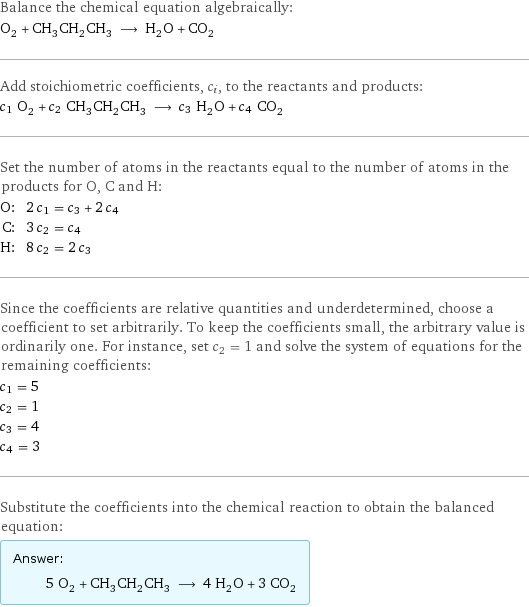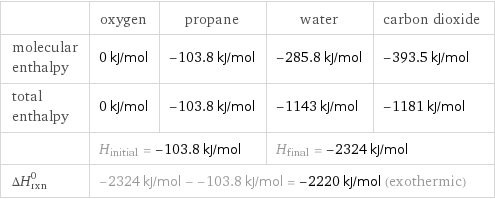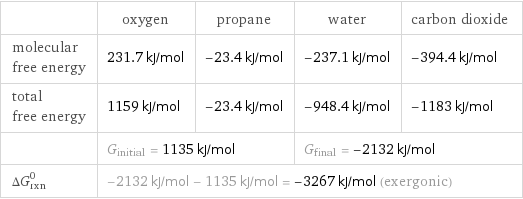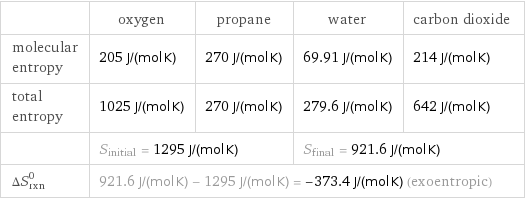Input interpretation

O_2 (oxygen) + CH_3CH_2CH_3 (propane) ⟶ H_2O (water) + CO_2 (carbon dioxide)
Balanced equation

Balance the chemical equation algebraically: O_2 + CH_3CH_2CH_3 ⟶ H_2O + CO_2 Add stoichiometric coefficients, c_i, to the reactants and products: c_1 O_2 + c_2 CH_3CH_2CH_3 ⟶ c_3 H_2O + c_4 CO_2 Set the number of atoms in the reactants equal to the number of atoms in the products for O, C and H: O: | 2 c_1 = c_3 + 2 c_4 C: | 3 c_2 = c_4 H: | 8 c_2 = 2 c_3 Since the coefficients are relative quantities and underdetermined, choose a coefficient to set arbitrarily. To keep the coefficients small, the arbitrary value is ordinarily one. For instance, set c_2 = 1 and solve the system of equations for the remaining coefficients: c_1 = 5 c_2 = 1 c_3 = 4 c_4 = 3 Substitute the coefficients into the chemical reaction to obtain the balanced equation: Answer: | | 5 O_2 + CH_3CH_2CH_3 ⟶ 4 H_2O + 3 CO_2
Structures

+ ⟶ +
Names

oxygen + propane ⟶ water + carbon dioxide
Reaction thermodynamics
Enthalpy

| oxygen | propane | water | carbon dioxide molecular enthalpy | 0 kJ/mol | -103.8 kJ/mol | -285.8 kJ/mol | -393.5 kJ/mol total enthalpy | 0 kJ/mol | -103.8 kJ/mol | -1143 kJ/mol | -1181 kJ/mol | H_initial = -103.8 kJ/mol | | H_final = -2324 kJ/mol | ΔH_rxn^0 | -2324 kJ/mol - -103.8 kJ/mol = -2220 kJ/mol (exothermic) | | |
Gibbs free energy

| oxygen | propane | water | carbon dioxide molecular free energy | 231.7 kJ/mol | -23.4 kJ/mol | -237.1 kJ/mol | -394.4 kJ/mol total free energy | 1159 kJ/mol | -23.4 kJ/mol | -948.4 kJ/mol | -1183 kJ/mol | G_initial = 1135 kJ/mol | | G_final = -2132 kJ/mol | ΔG_rxn^0 | -2132 kJ/mol - 1135 kJ/mol = -3267 kJ/mol (exergonic) | | |
Entropy

| oxygen | propane | water | carbon dioxide molecular entropy | 205 J/(mol K) | 270 J/(mol K) | 69.91 J/(mol K) | 214 J/(mol K) total entropy | 1025 J/(mol K) | 270 J/(mol K) | 279.6 J/(mol K) | 642 J/(mol K) | S_initial = 1295 J/(mol K) | | S_final = 921.6 J/(mol K) | ΔS_rxn^0 | 921.6 J/(mol K) - 1295 J/(mol K) = -373.4 J/(mol K) (exoentropic) | | |
Equilibrium constant
![Construct the equilibrium constant, K, expression for: O_2 + CH_3CH_2CH_3 ⟶ H_2O + CO_2 Plan: • Balance the chemical equation. • Determine the stoichiometric numbers. • Assemble the activity expression for each chemical species. • Use the activity expressions to build the equilibrium constant expression. Write the balanced chemical equation: 5 O_2 + CH_3CH_2CH_3 ⟶ 4 H_2O + 3 CO_2 Assign stoichiometric numbers, ν_i, using the stoichiometric coefficients, c_i, from the balanced chemical equation in the following manner: ν_i = -c_i for reactants and ν_i = c_i for products: chemical species | c_i | ν_i O_2 | 5 | -5 CH_3CH_2CH_3 | 1 | -1 H_2O | 4 | 4 CO_2 | 3 | 3 Assemble the activity expressions accounting for the state of matter and ν_i: chemical species | c_i | ν_i | activity expression O_2 | 5 | -5 | ([O2])^(-5) CH_3CH_2CH_3 | 1 | -1 | ([CH3CH2CH3])^(-1) H_2O | 4 | 4 | ([H2O])^4 CO_2 | 3 | 3 | ([CO2])^3 The equilibrium constant symbol in the concentration basis is: K_c Mulitply the activity expressions to arrive at the K_c expression: Answer: | | K_c = ([O2])^(-5) ([CH3CH2CH3])^(-1) ([H2O])^4 ([CO2])^3 = (([H2O])^4 ([CO2])^3)/(([O2])^5 [CH3CH2CH3])](../image_source/31e5196460c7b05d6857e84c0332cde1.png)
Construct the equilibrium constant, K, expression for: O_2 + CH_3CH_2CH_3 ⟶ H_2O + CO_2 Plan: • Balance the chemical equation. • Determine the stoichiometric numbers. • Assemble the activity expression for each chemical species. • Use the activity expressions to build the equilibrium constant expression. Write the balanced chemical equation: 5 O_2 + CH_3CH_2CH_3 ⟶ 4 H_2O + 3 CO_2 Assign stoichiometric numbers, ν_i, using the stoichiometric coefficients, c_i, from the balanced chemical equation in the following manner: ν_i = -c_i for reactants and ν_i = c_i for products: chemical species | c_i | ν_i O_2 | 5 | -5 CH_3CH_2CH_3 | 1 | -1 H_2O | 4 | 4 CO_2 | 3 | 3 Assemble the activity expressions accounting for the state of matter and ν_i: chemical species | c_i | ν_i | activity expression O_2 | 5 | -5 | ([O2])^(-5) CH_3CH_2CH_3 | 1 | -1 | ([CH3CH2CH3])^(-1) H_2O | 4 | 4 | ([H2O])^4 CO_2 | 3 | 3 | ([CO2])^3 The equilibrium constant symbol in the concentration basis is: K_c Mulitply the activity expressions to arrive at the K_c expression: Answer: | | K_c = ([O2])^(-5) ([CH3CH2CH3])^(-1) ([H2O])^4 ([CO2])^3 = (([H2O])^4 ([CO2])^3)/(([O2])^5 [CH3CH2CH3])
Rate of reaction
![Construct the rate of reaction expression for: O_2 + CH_3CH_2CH_3 ⟶ H_2O + CO_2 Plan: • Balance the chemical equation. • Determine the stoichiometric numbers. • Assemble the rate term for each chemical species. • Write the rate of reaction expression. Write the balanced chemical equation: 5 O_2 + CH_3CH_2CH_3 ⟶ 4 H_2O + 3 CO_2 Assign stoichiometric numbers, ν_i, using the stoichiometric coefficients, c_i, from the balanced chemical equation in the following manner: ν_i = -c_i for reactants and ν_i = c_i for products: chemical species | c_i | ν_i O_2 | 5 | -5 CH_3CH_2CH_3 | 1 | -1 H_2O | 4 | 4 CO_2 | 3 | 3 The rate term for each chemical species, B_i, is 1/ν_i(Δ[B_i])/(Δt) where [B_i] is the amount concentration and t is time: chemical species | c_i | ν_i | rate term O_2 | 5 | -5 | -1/5 (Δ[O2])/(Δt) CH_3CH_2CH_3 | 1 | -1 | -(Δ[CH3CH2CH3])/(Δt) H_2O | 4 | 4 | 1/4 (Δ[H2O])/(Δt) CO_2 | 3 | 3 | 1/3 (Δ[CO2])/(Δt) (for infinitesimal rate of change, replace Δ with d) Set the rate terms equal to each other to arrive at the rate expression: Answer: | | rate = -1/5 (Δ[O2])/(Δt) = -(Δ[CH3CH2CH3])/(Δt) = 1/4 (Δ[H2O])/(Δt) = 1/3 (Δ[CO2])/(Δt) (assuming constant volume and no accumulation of intermediates or side products)](../image_source/76924312be48e9b3a7ffccbd2e68b18a.png)
Construct the rate of reaction expression for: O_2 + CH_3CH_2CH_3 ⟶ H_2O + CO_2 Plan: • Balance the chemical equation. • Determine the stoichiometric numbers. • Assemble the rate term for each chemical species. • Write the rate of reaction expression. Write the balanced chemical equation: 5 O_2 + CH_3CH_2CH_3 ⟶ 4 H_2O + 3 CO_2 Assign stoichiometric numbers, ν_i, using the stoichiometric coefficients, c_i, from the balanced chemical equation in the following manner: ν_i = -c_i for reactants and ν_i = c_i for products: chemical species | c_i | ν_i O_2 | 5 | -5 CH_3CH_2CH_3 | 1 | -1 H_2O | 4 | 4 CO_2 | 3 | 3 The rate term for each chemical species, B_i, is 1/ν_i(Δ[B_i])/(Δt) where [B_i] is the amount concentration and t is time: chemical species | c_i | ν_i | rate term O_2 | 5 | -5 | -1/5 (Δ[O2])/(Δt) CH_3CH_2CH_3 | 1 | -1 | -(Δ[CH3CH2CH3])/(Δt) H_2O | 4 | 4 | 1/4 (Δ[H2O])/(Δt) CO_2 | 3 | 3 | 1/3 (Δ[CO2])/(Δt) (for infinitesimal rate of change, replace Δ with d) Set the rate terms equal to each other to arrive at the rate expression: Answer: | | rate = -1/5 (Δ[O2])/(Δt) = -(Δ[CH3CH2CH3])/(Δt) = 1/4 (Δ[H2O])/(Δt) = 1/3 (Δ[CO2])/(Δt) (assuming constant volume and no accumulation of intermediates or side products)
Chemical names and formulas

| oxygen | propane | water | carbon dioxide formula | O_2 | CH_3CH_2CH_3 | H_2O | CO_2 Hill formula | O_2 | C_3H_8 | H_2O | CO_2 name | oxygen | propane | water | carbon dioxide IUPAC name | molecular oxygen | propane | water | carbon dioxide